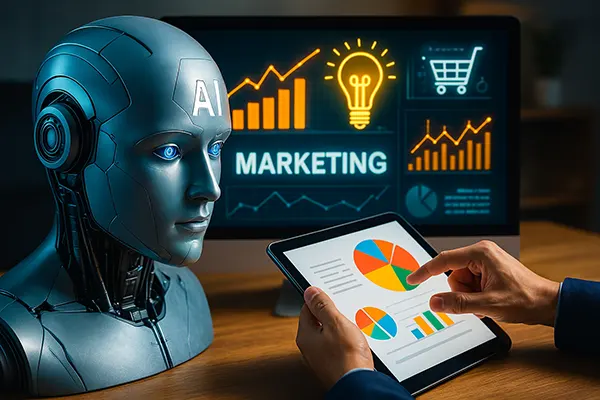
Marketing with Artificial Intelligence: How AI is Transforming Advertising and Personalisation
In recent years, artificial intelligence (AI) has become a cornerstone of digital marketing strategies. From hyper-targeted ads to real-time personalisation, AI has redefined how brands interact with their audiences. As of February 2025, the influence of AI on advertising and marketing is no longer a trend—it’s a standard. This article explores how businesses are embracing AI to stay ahead in an ever-evolving digital environment.
AI-driven Targeting and Audience Segmentation
AI algorithms have revolutionised how marketers analyse and segment audiences. With access to vast amounts of data, machine learning models can identify behavioural patterns, purchase intent, and user preferences far beyond what traditional tools can offer. This enables more precise targeting and improves return on investment across campaigns.
As of 2025, platforms like Google Ads and Meta Ads have fully integrated AI into their ecosystems, allowing advertisers to use predictive analytics for bidding strategies, keyword selection, and demographic targeting. These systems continually learn and adapt based on campaign performance, offering unparalleled efficiency.
Furthermore, AI helps marketers create micro-segments based on niche interests, browsing habits, and even sentiment analysis. This level of granularity means brands can deliver personalised content at scale, increasing the chances of engagement and conversions without significantly increasing ad spend.
Real-time Personalisation at Scale
One of AI’s strongest applications is dynamic content personalisation. AI-powered recommendation engines, such as those used by Amazon and Netflix, are now being adopted across ecommerce and content platforms. These systems curate product or content suggestions tailored to individual users, significantly enhancing customer satisfaction and retention.
Real-time personalisation isn’t limited to content delivery. Email marketing platforms like Mailchimp and Klaviyo now use AI to tailor email subject lines, sending times, and content blocks based on the recipient’s past behaviour. This creates more relevant interactions and increases open and click-through rates.
In 2025, many brands have moved beyond basic personalisation towards predictive personalisation. This means using AI to anticipate customer needs before they arise, offering proactive recommendations and tailored experiences that deepen customer loyalty and lifetime value.
Automated Content Creation and Ad Optimisation
AI-powered content creation tools have matured significantly. Tools like Jasper and Copy.ai generate blog posts, ad copy, and product descriptions that closely mimic human writing. In digital advertising, this means producing multiple ad variations quickly and efficiently, allowing marketers to test different messaging strategies in real time.
Ad optimisation is also now heavily automated. Platforms such as Google Performance Max or Meta Advantage+ use AI to autonomously test ad creatives, placement, and targeting to achieve optimal outcomes. Marketers provide the goals and assets, and the platform iteratively refines the campaign for better performance.
Crucially, these systems incorporate real-time feedback loops. As user behaviour changes—be it seasonal trends, global events, or shifting market sentiment—AI models adjust campaign elements instantly, reducing waste and maximising relevance without manual intervention.
Improving Creative Strategy with AI Insights
Beyond automation, AI assists marketers in making strategic creative decisions. Platforms such as Canva and Adobe Sensei now analyse performance data to suggest creative elements that resonate with specific demographics. This allows designers and marketers to develop assets that are not only aesthetically appealing but also data-informed.
Sentiment analysis tools integrated into social media platforms enable brands to gauge emotional responses to campaigns. This feedback is invaluable when crafting narratives or visual themes that align with customer values, particularly in culturally sensitive markets.
Moreover, AI tools offer predictive visual analytics—highlighting which image layouts, colours, and formats are most likely to succeed based on historical data. This enables design teams to reduce guesswork and allocate resources to creatives with the highest impact potential.

Ethics, Transparency, and Responsible AI Use
With the growing integration of AI into marketing, ethical considerations are more important than ever. Consumers are increasingly concerned about data privacy and algorithmic bias. As a result, marketers must adopt transparent AI practices that respect user data and adhere to evolving regulations such as the EU’s AI Act and GDPR updates in 2025.
Leading brands are now disclosing when AI is used in content generation or customer service interactions. Transparency fosters trust, especially in sectors like finance and healthcare where accuracy and credibility are paramount. Companies that ignore this trend risk reputational damage and regulatory penalties.
Furthermore, businesses are investing in explainable AI (XAI) systems that can justify how decisions are made—whether it’s targeting a specific user or recommending a product. This not only improves internal accountability but also ensures that AI aligns with brand values and user expectations.
Building Trust with Human-Centric AI
Trust remains the foundation of any successful marketing strategy. AI should enhance—not replace—the human element. Brands that use AI to augment empathy and relevance are seeing the highest engagement rates. For example, chatbots with natural language processing now offer customer support that feels genuinely helpful rather than robotic.
Human oversight in AI-driven campaigns is essential. This includes continuous monitoring of performance, correcting any missteps, and ensuring that AI tools are used in alignment with user interests. Responsible AI use not only safeguards brand reputation but also contributes to long-term customer relationships.
Ultimately, AI is most powerful when it complements human creativity and judgement. Brands that strike this balance will continue to thrive in a marketing landscape where personalisation, transparency, and ethical standards are paramount.

